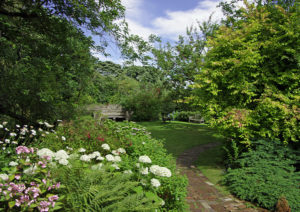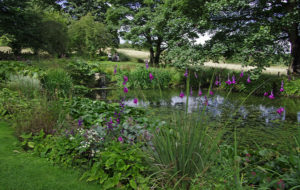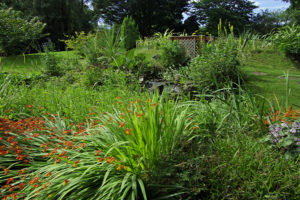“Crook Hall”:http://crookhallgardens.co.uk/
is a medieval building with Jacobean and Georgian additions which nestles among the trees above the backs of the River Wear. It is just a short walk from the city centre but completely hidden from the hustle and bustle of Durham. Daughter had visited the gardens a few years ago and said how good they were. This was my first visit and she is definitely right. The gardens climb up from the river and face south. It is ideal growing conditions and the soil is black and very fertile. Plants flourish here. A series of small almost secret gardens flow into each other. Each is very different and they all work together to complement the whole. Looking at the wild almost jungle like growth of the untamed river bank makes you realise what a labour of love it has been to establish and maintain the gardens.
By late August, the roses were past their best and many of the flowers were finished, but there was plenty to see and enjoy. There are plenty of seats scattered round the gardens and there is the house to visit too. On sunny days, afternoon teas served in the garden are very popular.
There is a modern tea room with a small shop by the road and tickets are obtained here. The area above this used to be a wild flower meadow, but is now planted with a maze. Tucked away in the bottom corner is the quiet corner with an outcrop of rock which could be a stand in for the Loch Ness Monster. This is a popular spot for children to play and scramble.
The path climbs up beside the wall of the Secret Garden to a wooden gate leading into the Wooded Glade.
I began with the walled Secret and Georgian Gardens, the oldest gardens which once provided the hall with fruit, vegetables and flowers.
Entry to the Secret garden is through a wooded door and another doorway leads into the Georgian Garden beyond. A gravel path runs round the inside of the wall and the garden is divided into two lawned areas, one with a table and chairs, the other with a small pergola. Vegetation is lush if not rampant, with ferns, montbretia, salvia, old fruit trees, old fashioned roses, walnut, spirea, holly, ivy, kerria, St John’s wort, Welsh poppies, winter jasmine, wild strawberries, geraniums, pelargoniums…
Beyond is the Georgian Garden which was a formal C18th garden and is now a flower garden with many cottage garden favourites including Marguerite daisies, golden rod, phlox, delphiniums, mulleins, dahlias, hosta, geraniums, Summach, roses, honeysuckle, bistort…
At the bottom of the garden is the small fernery, transformed from a small car parking space. There aren’t many ferns but there are hostas and zebra grass as well as house leaks growing in the seat of an old wooden chair. There are views to the south with the castle and cathedral.
To the north of the house is the large woodland glade which leads to the Moat Pond and the vegetable garden.
To the east is a series of gardens separated by tall hedges. The first is the Cathedral Garden with good views to the Cathedral and across The Sands to the opposite banks of the River Wear. It is a large grassy area surrounded by flower borders. The small topiary box trees represents monks.
Beyond is the Shakespeare garden with a stone bust of Shakespeare. The statue of a lady has been named Anne Hathaway. It is divided into four by low clipped yew hedges and there is a small pergola at the centre. It is planted with typical C16th plants including lavender, larkspur, marjoram, achillea, Japanese anemones and day lilies.
Through the gate is the orchard with old varieties of apples, plums, greengage and a cherry tree. Soft fruits grows in the border on one side. On the other border are mullein and foxglove with pink Cosmos at the far end.
Reached through the gap in the hedge is the Silver and White garden which was planted with white lobelia, cosmos and dianthus.
At the top of the garden is the Moat Pond, surrounded by trees with a small wooden bridge and small waterfall into a smaller pond which is now filling up with buttercups and montbretia.
The small vegetable garden with a greenhouse is to the west of the wooded glade and provides vegetables and herbs for the kitchen. The scarecrow is appropriately named Elvis.
These are lovely gardens with plenty of seats to sit and enjoy them. The only indication you are close to civilisation is the traffic noise and the sound of the occasional train.
The house and gardens are open Sunday to Wednesday 11-5 in the summer and 11-3 in the winter. There is pay and display parking by the shop and more pay and display perking along Frankland Lane. The cafe is open daily from 9.30-5.
The post code is DH1 5SZ and the grid reference is NZ 275431.
There are more pictures “here.”:http://is a medieval building with Jacobean and Georgian additions which nestles among the trees above the backs of the River Wear. It is just a short walk from the city centre but completely hidden from the hustle and bustle of Durham. Daughter had visited the gardens a few years ago and said how good they were. This was my first visit and she is definitely right. The gardens climb up from the river and face south. It is ideal growing conditions and the soil is black and very fertile. Plants flourish here. A series of small almost secret gardens flow into each other. Each is very different and they all work together to complement the whole. Looking at the wild almost jungle like growth of the untamed river bank makes you realise what a labour of love it has been to establish and maintain the gardens.
By late August, the roses were past their best and many of the flowers were finished, but there was plenty to see and enjoy. There are plenty of seats scattered round the gardens and there is the house to visit too. On sunny days, afternoon teas served in the garden are very popular.
There is a modern tea room with a small shop by the road and tickets are obtained here. The area above this used to be a wild flower meadow, but is now planted with a maze. Tucked away in the bottom corner is the quiet corner with an outcrop of rock which could be a stand in for the Loch Ness Monster. This is a popular spot for children to play and scramble.
The path climbs up beside the wall of the Secret Garden to a wooden gate leading into the Wooded Glade.
I began with the walled Secret and Georgian Gardens, the oldest gardens which once provided the hall with fruit, vegetables and flowers.
Entry to the Secret garden is through a wooded door and another doorway leads into the Georgian Garden beyond. A gravel path runs round the inside of the wall and the garden is divided into two lawned areas, one with a table and chairs, the other with a small pergola. Vegetation is lush if not rampant, with ferns, montbretia, salvia, old fruit trees, old fashioned roses, walnut, spirea, holly, ivy, kerria, St John’s wort, Welsh poppies, winter jasmine, wild strawberries, geraniums, pelargoniums…
Beyond is the Georgian Garden which was a formal C18th garden and is now a flower garden with many cottage garden favourites including Marguerite daisies, golden rod, phlox, delphiniums, mulleins, dahlias, hosta, geraniums, Summach, roses, honeysuckle, bistort…
At the bottom of the garden is the small fernery, transformed from a small car parking space. There aren’t many ferns but there are hostas and zebra grass as well as house leaks growing in the seat of an old wooden chair. There are views to the south with the castle and cathedral.
To the north of the house is the large woodland glade which leads to the Moat Pond and the vegetable garden.
To the east is a series of gardens separated by tall hedges. The first is the Cathedral Garden with good views to the Cathedral and across The Sands to the opposite banks of the River Wear. It is a large grassy area surrounded by flower borders. The small topiary box trees represents monks.
Beyond is the Shakespeare garden with a stone bust of Shakespeare. The statue of a lady has been named Anne Hathaway. It is divided into four by low clipped yew hedges and there is a small pergola at the centre. It is planted with typical C16th plants including lavender, larkspur, marjoram, achillea, Japanese anemones and day lilies.
Through the gate is the orchard with old varieties of apples, plums, greengage and a cherry tree. Soft fruits grows in the border on one side. On the other border are mullein and foxglove with pink Cosmos at the far end.
Reached through the gap in the hedge is the Silver and White garden which was planted with white lobelia, cosmos and dianthus.
At the top of the garden is the Moat Pond, surrounded by trees with a small wooden bridge and small waterfall into a smaller pond which is now filling up with buttercups and montbretia.
The small vegetable garden with a greenhouse is to the west of the wooded glade and provides vegetables and herbs for the kitchen. The scarecrow is appropriately named Elvis.
These are lovely gardens with plenty of seats to sit and enjoy them. The only indication you are close to civilisation is the traffic noise and the sound of the occasional train.
The house and gardens are open Sunday to Wednesday 11-5 in the summer and 11-3 in the winter. There is pay and display parking by the shop and more pay and display perking along Frankland Lane. The cafe is open daily from 9.30-5.
The post code is DH1 5SZ and the grid reference is NZ 275431.
http://wasleys.org.uk/eleanor/gardens/england/north/crook/index.html










